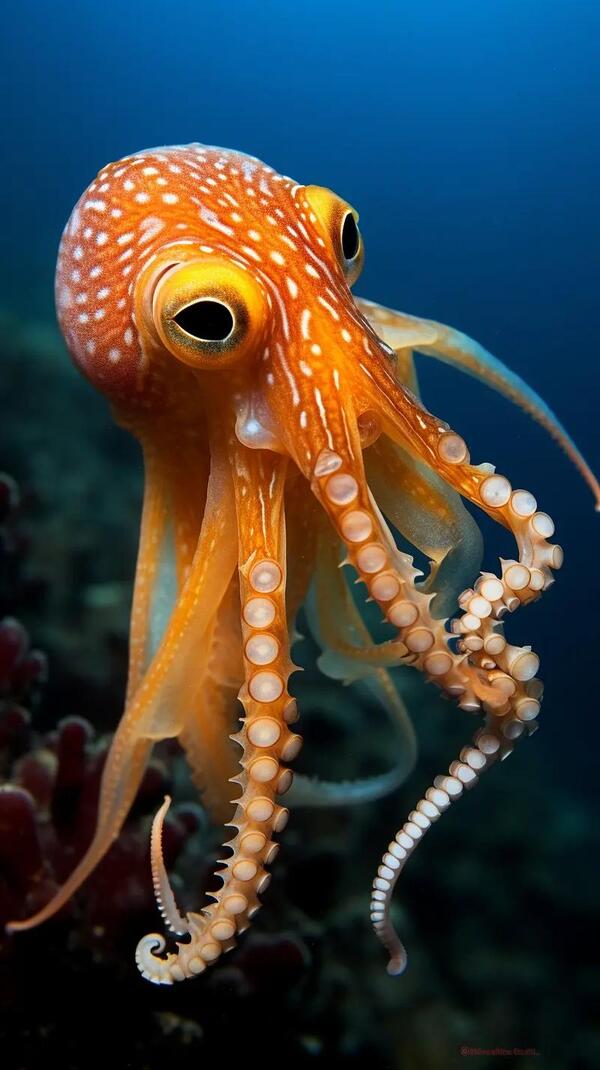Metamorphosis is an ability that animals have developed to survive, hunt, or protect themselves in their natural environment. While many people think of metamorphosis in terms of visual changes, such as color or shape, metamorphosis can also manifest as changes in body form, regeneration, chemical camouflage, or even behavioral changes. Below we will explore animals with metamorphosis in more detail and further explain how they use this ability to survive in their environment.

Octopuses have one of the most remarkable metamorphosis abilities in the animal kingdom. Not only can they rapidly change skin color and texture, they can also adapt to their surroundings by changing their body shape .
Deformation Mechanism :
Octopuses can rapidly adjust their color to mimic their surroundings by changing the size of pigment cells under their skin.
They have no bones, so they can compress or expand their soft bodies to fit into small caves or crevices.
Some octopuses can even imitate other marine creatures, such as highly poisonous flounders and sea snakes, to scare off their natural enemies.
Chameleons are another animal known for their shapeshifting, but their "shapeshifting" is primarily color-changing. Pigment cells in a chameleon's skin adjust their color in response to external stimuli such as light, temperature, and mood.
Deformation Mechanism :
Chameleons have two layers of pigment cells in their skin: cells in the surface layer contain pigments of different colors, while cells in a deeper layer can reflect different wavelengths of light, allowing them to quickly adjust the color of their skin.
Chameleons change color for more than just camouflage; they also use color to communicate with other chameleons. For example, male chameleons may use bright colors to advertise their territory to other males or to attract females.
Squids, like octopuses, have amazing color-changing and camouflage abilities. They can change not only their color, but also the texture of their skin and the way it reflects light. Squids’ camouflage techniques are so sophisticated that they are almost unrecognizable among sand, rocks or seaweed.
Deformation Mechanism :
Cuttlefish also have chromatophores in their skin, and they are able to use these to change color in milliseconds.
Cuttlefish also have tiny muscles in their skin that can tighten or relax, giving their skin a smooth or bumpy texture so they can mimic their surroundings.
The flatworm's ability to transform lies in its amazing regenerative abilities .
Deformation Mechanism :
Flatworms are able to regenerate new body parts, even heads or tails, using their stem cell system. This regeneration process is essential for their survival and reproduction.
Practical application scenarios : When facing a threat, flatworms confuse predators by breaking their bodies, and then rely on their regenerative ability to quickly restore their bodies.
Pufferfish can inflate themselves into a ball by sucking in large amounts of water or air, greatly changing their appearance. This deformation not only scares off predators, but the pufferfish's inflated spines can also stab predators.
Deformation Mechanism :
The puffer fish rapidly inhales water through its mouth, swelling its body. As it swells, the spikes on the surface of its skin stand up, forming a defensive barrier.
Survival Advantages :
Self-defense : Pufferfish rapidly increase in size and erect spikes to make themselves difficult to swallow, while the spikes can also damage enemies.
Glass frogs get their name because their belly skin is almost completely transparent. The frog's internal organs can be seen through the skin, and this transparency provides them with a unique form of camouflage.
Deformation Mechanism :
The glass frog's transparent skin allows them to blend into their environment, especially when they are perched on leaves or branches, where their transparent abdomen makes them difficult to spot.
Certain species of sea hares, especially the Spanish dancing
or sea hare** ( Hexabranchus sanguineus ),
Deformation Mechanism :
Sea slugs can use muscles to control the expansion and contraction of their bodies and quickly change their appearance.
The Spanish Dancer sea hare's brightly colored bodies are used not only to confuse predators, but also to send a warning signal that they are toxic.
8. Amoeba
Amoeba is a tiny single-celled organism that gets its name from its ever-changing shape. It has no fixed form and can move around in a microscopic environment, capture food, and respond to the outside environment by extending or retracting its pseudopodia.
Deformation Mechanism :
Amoeba change shape using pseudopodia, temporary structures propelled by the cytoplasm, which not only help them move, but also can be used to capture prey.
Their cell structure is very flexible and can adjust its shape in response to external stimuli.
Mantis shrimp are known for their powerful attacks, with their forelimbs able to eject in a very short time to strike prey or predators. This fast and powerful movement demonstrates the mantis shrimp's shape-shifting potential.
Deformation Mechanism :
The mantis shrimp's forelimbs have a special hinge structure that allows them to store energy in a short period of time, then suddenly stretch it out to attack the target at an extremely high speed.
Their movements are fast enough to create a "cavitation effect," the shock wave produced when bubbles in the water collapse, causing double damage to prey or enemies.
Metamorphosis is a key survival skill in the animal world, with different species of animals changing their morphology in various ways to adapt to the environment, hunt, escape predators, or communicate with their own kind. From octopuses and squids in the deep ocean to amoebas in the microscopic world, these animals demonstrate amazing evolutionary potential and diversity. Their ability to shapeshift not only helps them adapt to changing environments, but also demonstrates the endless innovation and vitality of nature.
Every animal has a unique survival strategy, and metamorphosis is an important tool for them to stand out in nature. Whether through changes in color, shape, or through regeneration or expansion, metamorphosis allows these animals to survive in extreme environments and ensure the continuation of their populations.
animal tags: Octopus Chameleon Cuttlefish Flatworm Pufferfish Glass-Frog Sea-Slug
We created this article in conjunction with AI technology, then made sure it was fact-checked and edited by a Animals Top editor.
you may also like

The appearance of a German Shepherd Dog should meet its standards, including size, coat color and appearance characteristics. When purchasing a German Shepherd, you should choose an individual that meets the standards to ensure a healthy and stable personality.The following are some of the ideal app...

If your cat's tongue keeps hanging out, there could be several reasons: 1. Lip licking during heat waves: When cats feel hot or thirsty, they can lick their lips to help themselves feel cool or rehydrated. This behavior is usually temporary and the tongue will be withdraw...

Both the Anbu turtle and the yellow-margined turtle are relatively easy to keep, but they have some differences. Anbu turtles are generally more active and require larger bodies of water and swimming space. They also prefer eating meaty foods such as bugs, insects and fish. Therefore...

Hermit crabs are crabs that use the shells of shellfish as a protective home. They usually live in coastal areas of the ocean or freshwater. Hermit crabs will adopt some strategies to adapt to the cold environment during the winter. The following is a detailed introduction to how hermit crabs...

After a female cat is neutered, it usually takes some time to recover. Specific recovery times may vary based on individual differences in cats and the type of surgery, but the following is a typical recovery timeline: 1. The day of surgery: Your cat may still be under an...

Abalone is not actually a fish, but a type of marine shellfish in the family Haliotidae of the phylum Mollusca. Although they are often referred to as "fish," they are not actually part of the same group of organisms as fish. Fish belong to the phylum Chordata and have the character...

The Chinese Big-Headed Turtle (English name: Chinese Big-Headed Turtle, scientific name: Platysternon megacephalum) is a semi-aquatic turtle living in southern China and northern Vietnam. It is an old turtle and is considered one of the most primitive side-necked turtles.The dragon-headed turtle has...

Humans have been smitten with cats for roughly 9,500 years. Today, tens of millions share our homes, yet we still puzzle over a deceptively simple question: what do cats think of their people? Research suggests cats read some of our social cues and emotions, but—compared with dogs—they’re likely...
Email: jsset668#gmail.com (change # to @) Please indicate your purpose of visit! Guangdong ICP No. 2022053326 XML| map| Chinese

